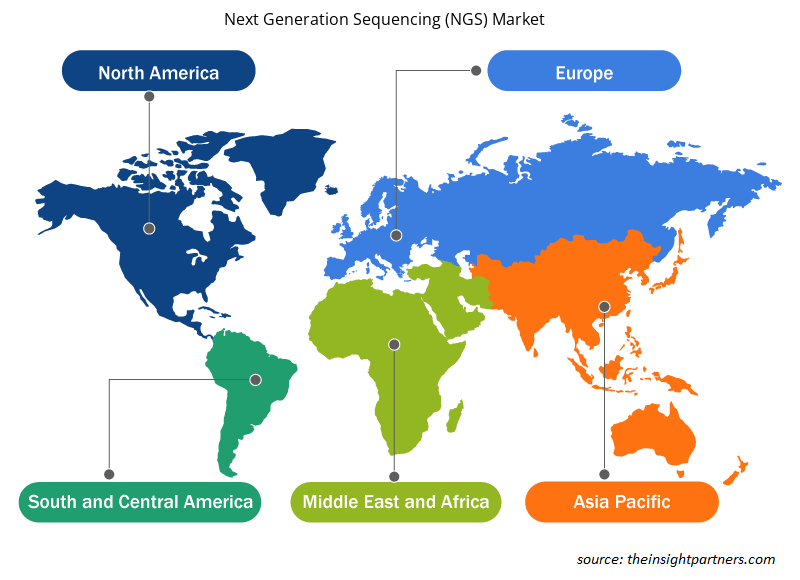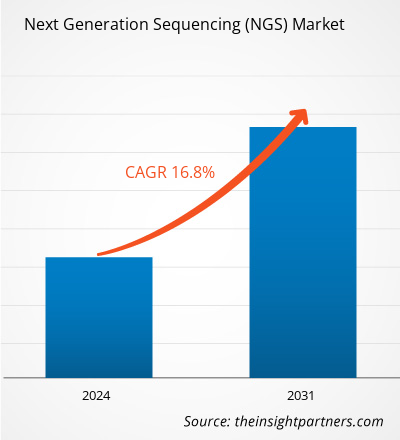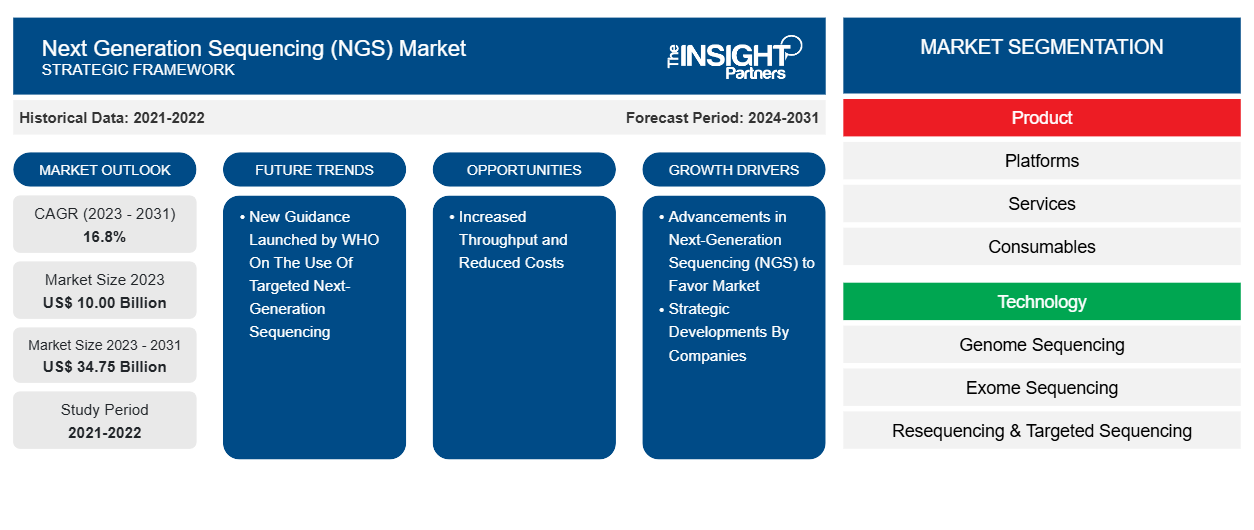Si prevede che il mercato del sequenziamento di nuova generazione (NGS) raggiungerà i 34,75 miliardi di dollari entro il 2031, rispetto ai 10,00 miliardi di dollari del 2023.Si prevede che il mercato registrerà un CAGR del 16,8% nel periodo 2023-2031. L'aumento della produttività e la riduzione dei costi rimarranno probabilmente le tendenze chiave del mercato.
Analisi di mercato del sequenziamento di nuova generazione (NGS)
Secondo il CDC, ogni anno 41 milioni di decessi sono dovuti a malattie non trasmissibili (NCD), equivalenti al 74% di tutti i decessi a livello globale. Di tutti i decessi per NCD, il 77% si verifica nei paesi a basso e medio reddito. Le malattie cardiovascolari sono responsabili della maggior parte dei decessi per NCD, 17,9 milioni, seguite da tumori (9,3 milioni), malattie respiratorie (4,1 milioni) e diabete (2 milioni). I recenti miglioramenti nelle tecniche di sequenziamento hanno autorizzato la medicina di precisione a essere un modello per la prevenzione, la diagnosi e il trattamento delle malattie, implementato in particolare per il trattamento del cancro.
Panoramica del mercato del sequenziamento di nuova generazione (NGS)
Molte aziende stanno affrontando sviluppi strategici che supportano la crescita del mercato. Ad esempio, nel 2022, Illumina ha lanciato NovaSeq X Series per generare più di 20.000 genomi interi all'anno. Nello stesso anno, Ultima Genomics ha lanciato il sequenziamento a lettura breve e ha annunciato il sequenziatore del genoma da 100 USD. Insieme a tali lanci, sono attualmente in corso alcuni progressi o una nuova classe di sequenziamento del DNA, chiamata sequenziamento di terza generazione (TGS). Queste tecnologie possono sequenziare singole molecole di DNA senza amplificazione e consentono la costruzione di letture molto più lunghe di NGS. Ogni tecnologia può produrre letture molto lunghe fino a 15.000 basi da singole molecole di DNA e RNA.
Personalizza questo report in base alle tue esigenze
Riceverai la personalizzazione gratuita di qualsiasi report, comprese parti di questo report, o analisi a livello nazionale, pacchetto dati Excel, oltre a usufruire di grandi offerte e sconti per start-up e università
-
Scopri le principali tendenze di mercato in questo rapporto.Questo campione GRATUITO includerà analisi di dati che spaziano dalle tendenze di mercato alle stime e alle previsioni.
Driver e opportunità di mercato del sequenziamento di nuova generazione (NGS)
Progressi nel sequenziamento di nuova generazione (NGS) per favorire il mercato
Il sequenziamento di nuova generazione (NGS) porta con sé un cambiamento nella ricerca genomica, offrendo capacità senza pari per analizzare molecole di DNA e RNA in modo altamente produttivo e conveniente. Questa trasformazione ha aumentato i progressi della genomica in diversi ambiti. I recenti progressi sono stati diretti verso costi ridotti, sequenziamento più rapido e accurato e analisi dei dati migliorata. Ciò promette molto per sbloccare nuove intuizioni sulla genomica e migliorare la comprensione delle malattie e l'assistenza sanitaria personalizzata. I progressi NGS hanno avuto un impatto positivo su varie aree di ricerca, tra cui genomica clinica, malattie infettive, cancro e studi sul microbioma.
Nuove linee guida lanciate dall'OMS sull'uso del sequenziamento mirato di nuova generazione
A marzo 2024, l'Organizzazione Mondiale della Sanità (OMS) ha pubblicato delle raccomandazioni sull'uso di una nuova classe di tecnologie diagnostiche, i test NGS mirati per la diagnosi di tubercolosi farmaco-resistente (TB) nelle linee guida aggiornate sulla tubercolosi. L'OMS ha anche lanciato un nuovo portale di sequenziamento della TB con oltre 56.000 sequenze per le nuove linee guida. Il portale, sviluppato in collaborazione con FIND e Unitaid, rappresenta la knowledge base di sequenziamento e fenotipizzazione più avanzata per la TB. Ciò contribuirà alla comprensione collettiva delle mutazioni del genoma del Mycobacterium tuberculosis e della loro associazione con la resistenza ai farmaci.
Analisi della segmentazione del rapporto di mercato del sequenziamento di nuova generazione (NGS)
I segmenti chiave che hanno contribuito alla derivazione dell'analisi di mercato del Next Generation Sequencing (NGS) sono prodotto, tecnologia, applicazione e utente finale.
- In base al prodotto, il mercato del Next Generation Sequencing (NGS) è suddiviso in piattaforme, servizi e materiali di consumo. Il segmento dei materiali di consumo ha detenuto una quota di mercato maggiore nel 2023.
- In base alla tecnologia, il mercato è segmentato in sequenziamento del genoma, sequenziamento dell'esoma, risequenziamento e sequenziamento mirato e altro. Il segmento risequenziamento e sequenziamento mirato ha detenuto la quota maggiore del mercato nel 2023.
- Per applicazione, il mercato è segmentato in diagnostica, scoperta di farmaci, medicina di precisione e altro. Il segmento della diagnostica ha detenuto la quota maggiore del mercato nel 2023.
- In termini di utente finale, il mercato è suddiviso in istituti accademici e di ricerca, aziende farmaceutiche e biotecnologiche, ospedali e cliniche e altri. Gli istituti accademici e di ricerca hanno detenuto la quota maggiore del mercato nel 2023.
Analisi della quota di mercato del sequenziamento di nuova generazione (NGS) per area geografica
L'ambito geografico del rapporto di mercato sul sequenziamento di nuova generazione (NGS) è suddiviso principalmente in cinque regioni: Nord America, Asia Pacifico, Europa, Medio Oriente e Africa, Sud e Centro America.
Il Nord America ha dominato il mercato. Negli Stati Uniti, secondo i nuovi dati dei Centers for Disease Control and Prevention (CDC), il numero di casi di TB è aumentato nel 2023. Nel 2023, i casi sono aumentati del 16% rispetto al 2022, raggiungendo 9.615 casi di TB, il numero più alto segnalato dal 2013. Inoltre, 2,9 casi ogni 100.000 persone hanno rappresentato un aumento del 15% rispetto al 2022. Il governo sta prendendo l'iniziativa di ridurre il numero di TB. Ad esempio, per affrontare l'epidemia globale di TB entro il 2035, l'Organizzazione mondiale della sanità (OMS) ha definito varie strategie. Per andare d'accordo con l'OMS, le aziende stanno anche stringendo partnership strategiche. Ad esempio, nell'ottobre 2022, Illumina Inc. e GenoScreen hanno stretto un'alleanza che consente l'accesso globale a un pacchetto che combina prodotti di sequenziamento Illumina per rilevare la resistenza ai farmaci anti-TB e informare rapidamente le decisioni terapeutiche. Si prevede che nei prossimi anni l'area Asia-Pacifico crescerà con il CAGR più elevato.
Approfondimenti regionali sul mercato del sequenziamento di nuova generazione (NGS)
Le tendenze regionali e i fattori che influenzano il mercato del Next Generation Sequencing (NGS) durante il periodo di previsione sono stati ampiamente spiegati dagli analisti di Insight Partners. Questa sezione discute anche i segmenti e la geografia del mercato del Next Generation Sequencing (NGS) in Nord America, Europa, Asia Pacifico, Medio Oriente e Africa e Sud e Centro America.

- Ottieni i dati specifici regionali per il mercato del sequenziamento di nuova generazione (NGS)
Ambito del rapporto di mercato sul sequenziamento di nuova generazione (NGS)
| Attributo del report | Dettagli |
|---|---|
| Dimensioni del mercato nel 2023 | 10,00 miliardi di dollari USA |
| Dimensioni del mercato entro il 2031 | 34,75 miliardi di dollari USA |
| CAGR globale (2023-2031) | 16,8% |
| Dati storici | 2021-2022 |
| Periodo di previsione | 2024-2031 |
| Segmenti coperti |
Per Prodotto
|
| Regioni e Paesi coperti |
America del Nord
|
| Leader di mercato e profili aziendali chiave |
|
Densità degli attori del mercato del sequenziamento di nuova generazione (NGS): comprendere il suo impatto sulle dinamiche aziendali
Il mercato del Next Generation Sequencing (NGS) sta crescendo rapidamente, spinto dalla crescente domanda degli utenti finali dovuta a fattori quali l'evoluzione delle preferenze dei consumatori, i progressi tecnologici e una maggiore consapevolezza dei vantaggi del prodotto. Con l'aumento della domanda, le aziende stanno ampliando le loro offerte, innovando per soddisfare le esigenze dei consumatori e capitalizzando sulle tendenze emergenti, il che alimenta ulteriormente la crescita del mercato.
La densità degli operatori di mercato si riferisce alla distribuzione di aziende o società che operano in un particolare mercato o settore. Indica quanti concorrenti (operatori di mercato) sono presenti in un dato spazio di mercato in relazione alle sue dimensioni o al valore di mercato totale.
Le principali aziende che operano nel mercato del sequenziamento di nuova generazione (NGS) sono:
- Illumina, Inc.
- Thermo Fisher Scientific, Inc.
- Qiagen NV
- Istituto di genomica di Pechino
- Perkinelmer, Inc.
- F. Hoffmann-La Roche AG
Disclaimer : le aziende elencate sopra non sono classificate secondo un ordine particolare.

- Ottieni una panoramica dei principali attori del mercato del sequenziamento di nuova generazione (NGS)
Notizie di mercato e sviluppi recenti del sequenziamento di nuova generazione (NGS)
Il mercato del Next Generation Sequencing (NGS) viene valutato raccogliendo dati qualitativi e quantitativi dopo la ricerca primaria e secondaria, che include importanti pubblicazioni aziendali, dati di associazioni e database. Di seguito sono elencati alcuni degli sviluppi nel mercato del Next Generation Sequencing (NGS):
- A marzo 2022, come da comunicato stampa di Thermo Fisher Scientific, viene lanciato Ion Torrent Genexus Dx Integrated Sequencer con marchio CE-IVD, una piattaforma di sequenziamento di nuova generazione (NGS) che fornisce risultati in appena un giorno. Progettato per i laboratori clinici, il sistema completamente convalidato consente agli utenti di eseguire test diagnostici e ricerche cliniche su un unico strumento.
- Nell'ottobre 2022, il comunicato stampa di Illumina Inc. ha dichiarato di aver stretto una partnership con GenoScreen per accelerare i progressi per porre fine alla tubercolosi (TB) in tutto il mondo. La partnership amplierà le capacità dei paesi maggiormente colpiti dalla tubercolosi per rilevare e combattere in modo più efficace la TB multifarmaco-resistente (MDR-TB).
Copertura e risultati del rapporto di mercato sul sequenziamento di nuova generazione (NGS)
Il rapporto “Dimensioni e previsioni del mercato del sequenziamento di nuova generazione (NGS) (2021-2031)” fornisce un’analisi dettagliata del mercato che copre le seguenti aree:
- Dimensioni e previsioni del mercato del sequenziamento di nuova generazione (NGS) a livello globale, regionale e nazionale per tutti i segmenti di mercato chiave coperti dall'ambito
- Tendenze del mercato del sequenziamento di nuova generazione (NGS) e dinamiche di mercato come driver, vincoli e opportunità chiave
- Analisi dettagliata delle cinque forze PEST/Porter e SWOT
- Analisi di mercato del sequenziamento di nuova generazione (NGS) che copre le principali tendenze di mercato, il quadro globale e regionale, i principali attori, le normative e i recenti sviluppi del mercato
- Analisi del panorama industriale e della concorrenza che copre la concentrazione del mercato, l'analisi della mappa di calore, i principali attori e gli sviluppi recenti per il mercato del sequenziamento di nuova generazione (NGS)
- Profili aziendali dettagliati
- Analisi storica (2 anni), anno base, previsione (7 anni) con CAGR
- Analisi PEST e SWOT
- Valore/volume delle dimensioni del mercato - Globale, Regionale, Nazionale
- Industria e panorama competitivo
- Set di dati Excel
Report recenti
Testimonianze
Motivo dell'acquisto
- Processo decisionale informato
- Comprensione delle dinamiche di mercato
- Analisi competitiva
- Analisi dei clienti
- Previsioni di mercato
- Mitigazione del rischio
- Pianificazione strategica
- Giustificazione degli investimenti
- Identificazione dei mercati emergenti
- Miglioramento delle strategie di marketing
- Aumento dell'efficienza operativa
- Allineamento alle tendenze normative























 Ottieni un campione gratuito per - Mercato del sequenziamento di nuova generazione (NGS)
Ottieni un campione gratuito per - Mercato del sequenziamento di nuova generazione (NGS)